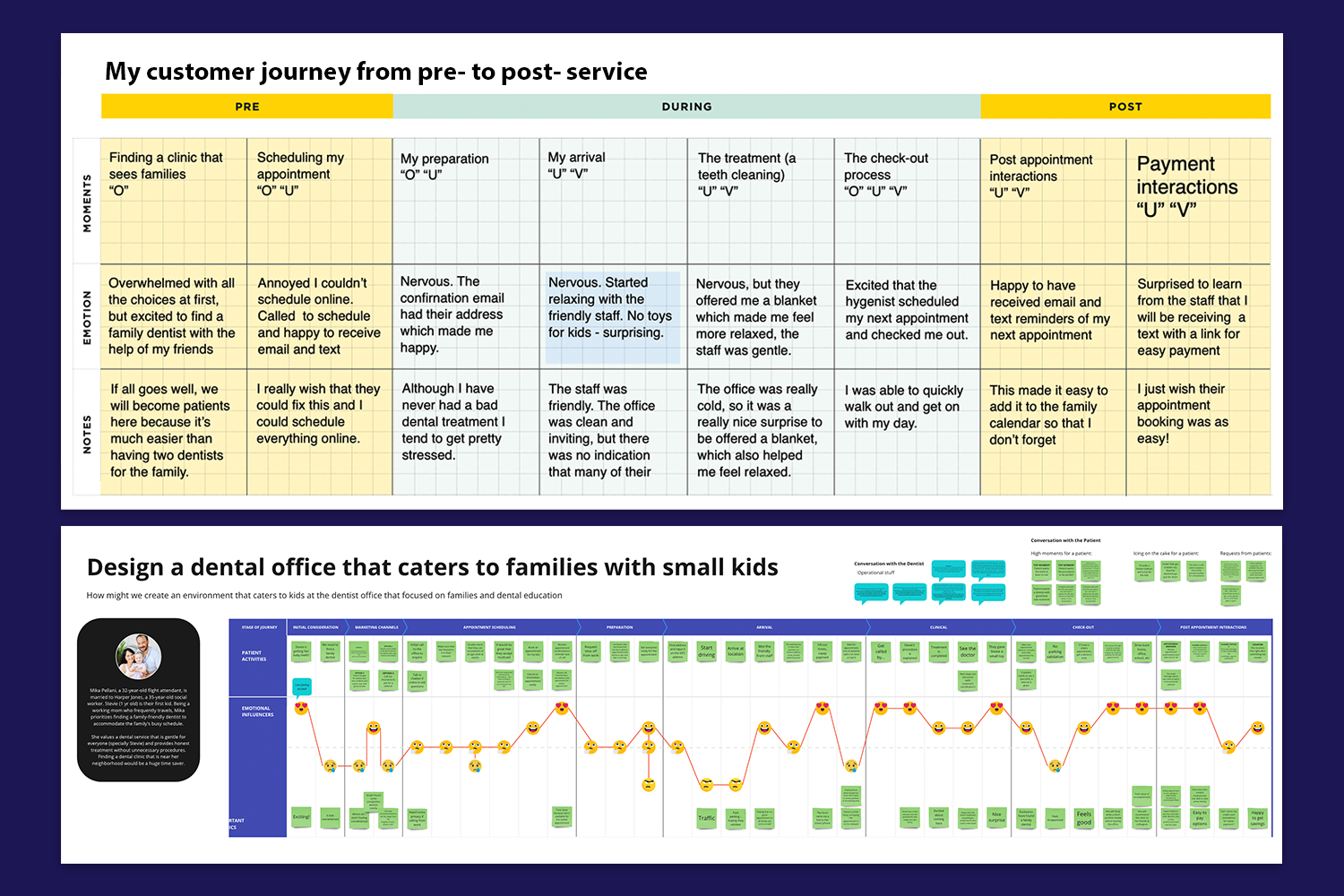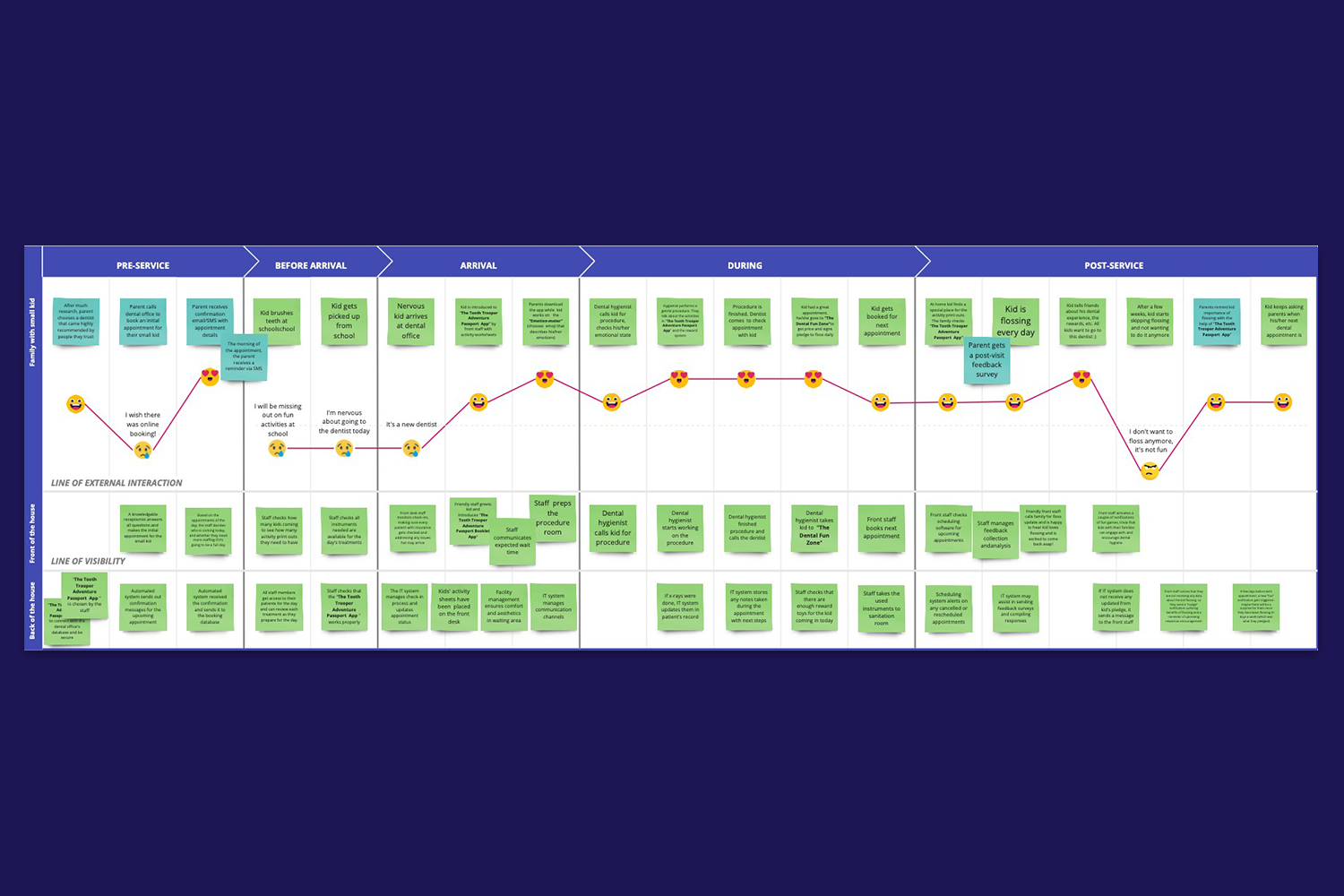IDEO U
User-Centered Service Design Certification
Overview
Service design is the craft of tying together human, digital, and physical interactions over time to create a truly differentiated experience for customers. Delivering great service can be challenging, but by using design thinking, I gained a deeper understanding of people's needs. By utilizing customer journey mapping, I identified areas for improvement and discovered opportunities to design meaningful moments. A service blueprint provided a holistic view and a clear vision of the end-to-end service ecosystem.
Identify Your Service Design Project
For this course, the service that I chose was:
A dental office that caters to families with small kids. For many people, including kids, visiting the dentist can bring feelings of fear and anxiety. It’s important to understand where this fear comes from and figure out how to overcome it, so that patients don’t miss out on dental care. Most people who are scared of going to the dentist have had bad experiences or haver hears stories about painful treatments during dental visits.
Also, things like the noise of drilling, strong smells, and seeing dental tools can make people more afraid of dental visits. These things together create an uncomfortable feeling, and some people might start avoiding going to the dentist because of it.
My ideal customer is:
A parent who is looking for a family dentist that can see all members of the family. They have dental insurance (medicaid or regular insurance). They tend to make the initial appointment for their kid, and if it’s a great experience, they will book appointments for the adults,
What do they value?
A dental office that is gentle, so they won’t hurt them.
The dentist and staff are honest, so they won’t oversell treatment and focus on what’s required (recommendations are ok).
Their time is valued, so the appointments are on time most of the time.
Why do they love the service? Why do they keep coming back?
All family members are treated with respect and care. They only receive the treatment that they need, with optional recommendations, so they don’t feel pressure to get.
What primary need does the service meet for them? Are there any other needs being met as well?
Dental care primarily, but at times patients can be referred to other medical specialities, for example to neurologists, oral surgeons, etc.
Journey Mapping
My assumptions before experiencing the service
The waiting area: Since the office caters to families, the waiting area will be medium or large . The check-in form is straightforward and easy to complete. I will see parents with their children waiting to be seen while a TV plays a movie. There might be a few toys strategically placed to entertain nervous kids. I expect to be greeted by a friendly staff.
The treatment rooms: I will experience an inviting and calming interior design. There might be pictures or a TV for entertaining kids during their treatment. The dentist will be patient, soft spoke, and friendly. I might see tools designed to educate kids on dental hygiene, such as toy toothbrushes with toy animals. Post-treatment toys or rewards would likely be provided to create a positive association with dental care.
The check-out process: Check-out and scheduling a follow-up appointment will be easy.
First-hand experience with the service (before observing the service experiences of others)
First interaction: Scheduling my appointment over the phone was a breeze—the process was straightforward. The staff was attentive, friendly, and knowledgeable. Their website was easy to find and all the information that I needed like their number and address was well organized. They don’t have online booking, which could have been more convenient for me. After booking, I was sent the intake form via text, which unfortunately I forgot to fill out.
Intended goals of the service: Offer family dentistry with a focus on educating both parents and young children about proper dental hygiene. The staff prioritizes building rapport to ensure a positive experience for kids, especially those who may feel nervous.
Good and bad elements of the service: The staff was kind and knowledgeable. I was sent the intake form as a text link on my phone, which I thought was really convenient. I noticed that they still give out printed forms for those patients who are more comfortable with pen and paper. The waiting area was small, and I didn’t see any of the usual magazines (or toys for kids) you see when waiting for appointments. The staff informed me that they removed them for hygiene post-Covid. The treatment room was chilly, so they offered blankets. Some equipment could be updated like their x-ray machine and cameras. As I headed to my treatment room, I enjoyed the soothing sound of a waterfall on one of the walls, appreciating the intentional interior design. The dentist took her time examining my teeth, explaining x-rays, and addressing my questions without any sense of rush. In the treatment room, the dental hygienist scheduled my follow-up appointment and handled the checkout process.
Anything else: The bathrooms had single-use toothbrushes, in case I needed to brush my teeth prior to my treatment. The treatment rooms were super clean and smelled nice. The interior design made me feel relaxed. The waiting area had a TV was playing the news, which I thought was a missed opportunity to show educational videos to foster dental hygiene education. After booking, I received a text message confirming my next appointment. Overall, my appointment went really well. However, I didn't notice any specific signs indicating that this dentist also treats children.
The top journey map outlines my first-hand experience with the service: my first dental appointment at this particular dental office from researching at finding the office, booking the appointment, arriving at the dental office and waiting for my treatment, getting my treatment, checking out process and booking my follow-up appointment.
The bottom journey map outlines the experience of Mika Pellani, a 32-year-old flight attendant, is married to Harper Jones, a 35-year-old social worker. Stevie (1 yr old) is their first kid. Being a working mom who frequently travels, Mika prioritizes finding a family-friendly dentist to accommodate the family's busy schedule. She values a dental service that is gentle for everyone (specially Stevie) and provides honest treatment without unnecessary procedures. Finding a dental clinic that is near her neighborhood would be a huge time saver.
Identify The Moments That Matter
Each moment was analyzed through the following lenses to prioritize all design efforts: operational, high value, and unique. The following questions were used as guide:
Is this moment critical to the successful operation and execution of this service?
Does this moment provide a clear opportunity to be unique?
Is this moment a driver of high value for the customer, or does it have the potential to be?
After analyzing the customer journey map service experience, it was time to determine the area(s) of the greatest potential to create unique value. Once the area of focus was defined, I created a series of storyboards which were shared with my stakeholders to get some feedback and validate the idea.
Feedback from the storyboards interviews
What did you like?
Parent: I would be pleasantly surprised and appreciative of the effort to make the dental experience enjoyable and educational for my little one
Kid: I am so excited about the rewards!!!!!… but also about learning how to better take care of my teeth.
Dentist: Introducing kid passports aligns with our goal of providing comprehensive and positive dental care. It not only makes the dental experience enjoyable for kids but also lays the foundation for a lifetime of good oral health habits. I would be excited to see the positive impact it would have on our young patients and their families.
What surprised you?
Parent: It would surprise me with its innovation, educational focus, and commitment to making my child's dental visits a positive and engaging experience. It would likely enhance my perception of the dental office and make me more enthusiastic about my child's oral health journey.
Kid: It’s just fun, I like it a lot!!
Dentist: Well, the success of the kid passport concept would be pleasantly surprising if it results in increased engagement, positive behavior changes, and an overall improvement in the dental experience for young patients and their families.
What would you do differently?
Parent: The idea of taking it home was a little concerning in case it gets lost, but they would likely implement strategies to avoid losing iy, such as designating a specific place at home where it's kept between appointments or making a digital copy in case the physical passport goes missing.
Kid: It would be nice to get rewards every time I go to see the dentist, like if I don’t have to do much at home :)
Dentist: Passports getting lost would be disappointing, so maybe something digital like an app? The rewards would still be given here at the office.
Reflections From The Storyboards
What were my initial expectations? Were they met? What worked as planned?
My expectations were that kids would have a better experience at the dental office and not be so nervous. They were met because the passport seemed to remove that scary feeling some kids have towards dentists, it focused them on fun activities. Kids seemed excited for their upcoming dental visit. Parents were excited that their dental office would introduce the concept of the kids’ passport. The dental office already focuses on educating families, so the passport concept aligned with their goals.
Based on these learnings, what updates should be explored?
There were concerns of the passport getting lost or broken, so it may be a good idea to go the digital route with some sort of simple app or cloud base platform that both families and dental office can access easily. If we go the digital route, some of the sections in the passport would need to be rethought because they don’t work digitally like the hands-on activities. These would need to become a component separate and maybe work like those kids’ menus that kids engage with when waiting for their food? Or eliminated altogether, although the kids liked the idea of engaging with them while waiting for their appointment…
Some of the sections that I am thinking are:
Coloring section
Toothbrushing, flossing, healthy eating (less sugar) checklist
Emoji section where they can draw how they are feeling about their appointment
Questions section for questions to the dentist or staff
Collect: stickers, badges, toys (depending on the scenario achievement - signing a pledge to floss dayly vs. having a good visit)
Educational trivia
From Journey Map to Blueprint
After validating the prototype and ideating on the future state of at least one of your moments, it was time to capture all of the details of my journey map by creating a blueprint map.
Extending beyond the journey map, this blueprint shows relationships and dependencies within the service. It visualizes the entire experience for all the parties involved. It helped me consider the elements that are visible to the customer (like the staff or the space itself) and those that happen behind the scenes (like the IT system or the facility management). Things like people, space, technology, and internal processes can work together to perform a task or evoke an emotion for the customer. This blueprint help me diagram the relationships between internal and external elements of the service, so I can better communicate my designs with those who will deliver and maintain the service.





